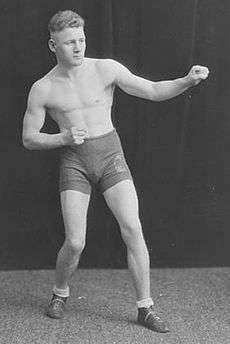Charlie Purdy
| Charlie Purdy | |
|---|---|
 | |
| Statistics | |
| Real name | Charles Francis Purdy |
| Nickname(s) | "Charlie" |
| Height | 154 |
| Nationality | New Zealand |
| Born |
24 November 1905 Auckland |
| Boxing record | |
| Total fights | 80 |
| Wins | 49 |
| Wins by KO | 1 |
| Losses | 21 |
| Draws | 6 |
| No contests | 4 |
Charles "Charlie" Purdy (born 24 November 1905, date of death unknown) was a New Zealand boxer who competed in the 1924 Summer Olympics.[1]
In 1924 he was eliminated in the first round of the lightweight class after losing his fight to Frenchman Jean Tholey. The result of the fight was controversial, Purdy, the crowd and one of the judges believing Purdy had clearly won the fight; the other judge and the French referee giving the fight to Tholey.[2][3]
After the Games he travelled to Dublin where he won the Irish welterweight title.[2]
He later moved to Australia; in 1929 losing the welterweight championship of Australia to Wally Hancock in Sydney by being knocked out for the first time; he was 10 st 2½ lb (58.3 kg).[4]
A 1935 report from Sydney said that Charles Francis Purdy a professional boxer had divorced his wife; on their wedding night she threw a glass at him and gashed his forehead, and he attended hospital five times due to her violence.[5]
He is remembered by the Charlie Purdy Cup of the Auckland Boxing Association, and for his weaving:
- Ralph Aitken "weaved and ducked like a Charlie Purdy." [6]
- Billy Parris "used Charlie Purdy’s famous weave." [7]
References
- ↑ New Zealand Olympic Committee: Charlie Purdy
- 1 2 Ron Palenski & Terry Maddaford: The Games Auckland: Moa Publications Ltd. ISBN 0-908570-62-7
- ↑ The Story So Far: 100 Years of Boxing New Zealand
- ↑ Evening Post (Wellington), 8 June 1929 p 10
- ↑ Evening Post (Wellington), 18 April 1935 p 11
- ↑ Evening Post (Wellington), 1 May 1936 p 14
- ↑ Auckland Star, 14 October 1944 p 3
- "Charlie Purdy". boxrec.com. Retrieved 18 June 2014.
- "Charlie Purdy". sports-reference.com. Retrieved 19 June 2014.
- Kiwis With Gloves On by Brian F O'Brien, published 1960, Reed.